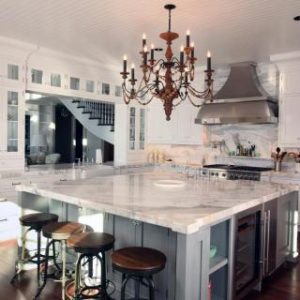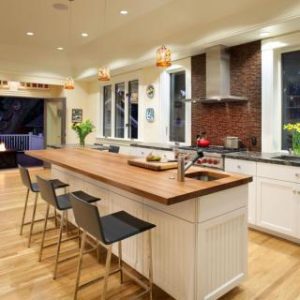21 Aug A Guide to Kitchen Countertops
If you’re in the market for kitchen countertops, keep in mind that in addition to aesthetics, the right material for your application is important.
First, consider how you’ll use your new kitchen and what kind of Denver cabinets you’ll install. Then, choose the counter that best fits your lifestyle. For example, a high-traffic area with heavy use requires a stain-resistant and durable surface. A less utilized area might be a great application for glass or custom fabrication. Whether you’re in it for the looks or the durability, there’s a countertop material out there that will work. Learn the ins and outs of the seven most popular countertop materials on the market today.
Granite
Often more affordable, this multi-colored, hard stone withstands most surface wear and tear—including scratches and dings—making it great for high-traffic family kitchens. Beware: Although it’s one of the tougher counters out there, it’s susceptible to staining if it’s not sealed.
Marble
Marble has a classic, luxurious look that most likely will never go out of style. Its color options range from white with gray veins to green and even pink. This stone is soft enough to scratch, so it needs to be treated with care. A honed, or matte, finish will hide more damage than a glossy, polished finish—but acidic foods leave permanent dull spots, called etching, that can’t be repaired. It develops a beautiful patina over time.
Quartz
Man-made quartz counters use resin to bond the quartz pieces, so a wide range of colors and finishes are possible—from soft, earthy tones to brighter, modern varieties. Some even mimic the look of natural stones like marble and soapstone. Big-time bonus: Quartz is hard and non-porous, so it resists both scratching and staining.
Soapstone
This rich, earthy stone is nearly stain-proof and many experts claim it gets better looking with age. Because it’s dense, it never needs to be sealed, but a thin coat of mineral oil is recommended every few months to give the stone a darker, richer look. Like marble, soapstone is soft enough to scratch and mark up through everyday use. Unlike marble, however, soapstone dings can be buffed out with very fine-grit sand paper.
Concrete
Since these countertops are made by pouring liquid concrete into specially designed molds, they’re great for customization and fitting within odd-shaped kitchens. Additionally, dye can be added, which makes them available in virtually every color imaginable. They can even be embellished with embedded glass, stones, or shells. Unsealed concrete countertops are vulnerable to staining. Engineered concrete countertops, though, sidestep this problem since they’re coated with an extra-strong sealer that sinks into its naturally porous surface. Raw materials are fairly inexpensive, but labor costs can be pricey.
Stainless Steel
This super contemporary surface, created by wrapping a sheet of metal around a wood fiber core, withstands moderate heat and resists stains. Though minor scratches are possible, they can be buffed out with scrubbing pads from a local grocery store.
Wood
A wood surface option is popular for kitchen islands because of its warm, inviting feel. It comes in a range of wood types and design styles, including: plank, with the boards facing up, edge-grain, with the boards facing sideways, and end-grain, with the ends of the boards facing up. Unlike other countertops, wood are great for food preparation when installed as butcher block. This is typically coated with mineral oil instead of a semi-permanent sealer.
To learn more about different kitchen countertop material options and what would be great for your space, contact us or visit our Denver showroom.



